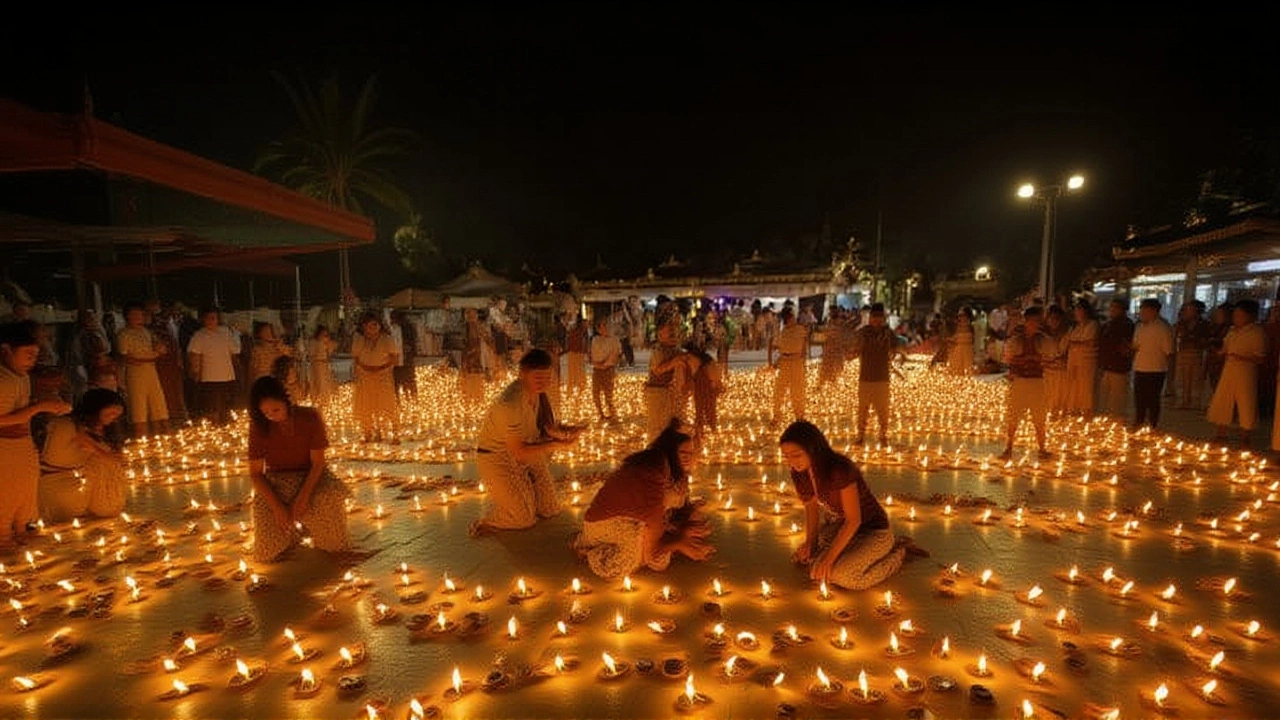- 0
On Monday evening, October 7, 2025, a motorized paraglider soaring over Chaung U township unleashed a bomb strike that left at least 40 civilians dead and dozens more injured during the Buddhist Thadingyut Festival of Lights. The attack, blamed on Myanmar’s ruling military junta, marks one of the deadliest aerial assaults since the coup, raising fresh alarms about the regime’s willingness to target civilians as it hustles toward a December election.
Background: Myanmar’s spiralling conflict
The country has been mired in a civil war ever since the military seized power on February 1, 2021. Resistance groups such as the People's Defence Force and ethnic armies like the Kachin Independence Army have fought the State Administration Council (SAC), the junta’s governing body. According to the United Nations Office for the Coordination of Humanitarian Affairs, air‑strike incidents jumped a staggering 350% between 2022 and 2023, a trend that shows no sign of easing.
Senior General Min Aung Hlaing, Commander‑in‑Chief of the Myanmar Armed Forces heads the SAC, which has increasingly relied on unconventional weapons as sanctions bite into its conventional air fleet.
Details of the Chaung U strike
Witnesses say the first explosion rang out at about 7:00 PM Myanmar Standard Time (UTC+6:30), puncturing the candle‑lit vigil that drew roughly 100 locals from nearby villages such as Kyaukmyaung, Myaung, and Pinlebu. Amnesty International Secretariat described the scene as a "gruesome reminder that civilians need urgent protection," while the National Unity Government (NUG) put the death toll at 24, with 47 wounded.
DW News correspondent Tommy Walker reported, “This is just another example of the military conducting an air strike on Myanmar’s population. They’ll claim they’re targeting terrorists, but the reality is a crowd of families, children, and elders were gathered for a festival of light.”
BBC Southeast Asia correspondent Jonathan Head added technical context, noting the weapon’s novelty: “The motorized paraglider, sometimes called a power‑gliding strike, is a low‑cost platform that lets the junta drop ordnance without the need for an operational jet or helicopter.”
Humanitarian and political fallout
Local hospitals were overwhelmed; the Chaung U Rural Health Centre reported receiving 80 patients with shrapnel wounds, burns, and crush injuries. The Assistance Association for Political Prisoners (AAPP) reminded the world that roughly 17,000 political prisoners remain behind bars, a key grievance driving the protest.
The United Nations High Commissioner for Refugees (UNHCR) estimates that 2.6 million people have been displaced internally since the coup, with another million seeking refuge in neighboring Thailand, India, and Bangladesh. The recent strike only deepens that humanitarian crisis, prompting renewed calls for a UN‑mandated ceasefire.
Reactions from the international community
- Amnesty International condemned the bombing, urging the Security Council to impose targeted sanctions on junta officials.
- The European Union announced a review of its sanctions regime, looking to expand asset freezes to include the military’s procurement networks.
- The United States’ Bureau of East Asian and Pacific Affairs called the attack a "war crime" and said it would explore additional diplomatic measures.
Meanwhile, the junta’s state‑run newspaper Myanma Alin stayed silent, a familiar pattern that underscores the regime’s opacity.
Why the motorized paraglider matters
The shift to paraglider‑based bomb delivery reflects a tactical adaptation. After sanctions crippled the Myanmar Air Force’s fleet, the military turned to cheaper, harder‑to‑detect platforms that can launch from remote hilltops. This method also complicates verification by satellite imagery, making accountability harder.
Security analysts warn that such low‑tech aerial weapons could become a staple in insurgent‑state conflicts worldwide, especially where traditional aviation assets are scarce.
Looking ahead: What’s next?
With a national election slated for December 2025, the junta appears to be ramping up intimidation tactics to suppress dissent ahead of the vote. Opposition groups, however, remain resolute, planning further peaceful demonstrations during upcoming religious holidays.
Humanitarian agencies are urging an emergency aid corridor into Sagaing Region, while diplomatic actors push for an ASEAN‑led peace dialogue. Whether those talks can prevent another tragedy like Chaung U remains uncertain.
Key facts
- Date of attack: October 7, 2025, around 7:00 PM local time.
- Location: Chaung U township, Sagaing Region, Myanmar.
- Weapon used: motorized paraglider dropping improvised explosives.
- Casualties: at least 40 dead, 80 injured (official figures vary).
- Event targeted: Thadingyut Festival of LightsChaung U township.
Frequently Asked Questions
How does this attack affect civilians in Sagaing Region?
The bombing has intensified fear among residents, disrupted daily life, and overwhelmed local health facilities. With 80 injured, many families now face medical bills and loss of breadwinners, compounding the already high displacement numbers in the region.
What prompted the junta to use a motorized paraglider?
International sanctions have crippled the Myanmar Air Force’s fleet, forcing the regime to adopt low‑cost, low‑visibility platforms. Paragliders can be launched from remote hills, bypassing radar detection and avoiding the need for expensive aircraft maintenance.
Who are the main opposition groups responding to the strike?
The National Unity Government, representing the ousted civilian leadership, has condemned the attack and called for international intervention. Ethnic armed organizations such as the Kachin Independence Army and the Arakan Army have also voiced solidarity, while the People's Defence Force urges continued protests.
What international actions are being considered?
The United States has labeled the bombing a war crime, and the EU is reviewing its sanction package. The UN Human Rights Council is slated to discuss the incident at its next session, with calls for a referral to the International Criminal Court.
What does this mean for the upcoming December 2025 election?
The junta appears to be tightening its grip ahead of the vote, using terror to silence dissent. Opposition observers warn that the violence could delegitimize any election outcome, potentially sparking further unrest across the country.

